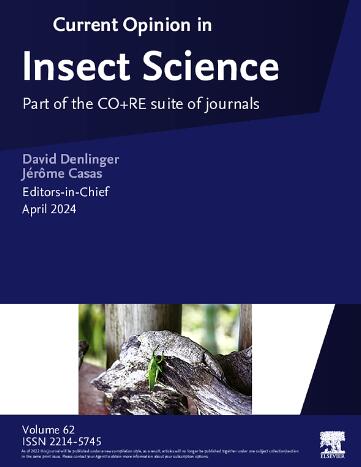The effect of biogenic amines in the neuromodulation of insect social behavior
IF 4.8
1区 农林科学
Q1 BIOLOGY
引用次数: 0
Abstract
Interactions among colony members in insect societies involve a wide range of behaviors, including collective defense, recruitment, foraging, and parental care. Despite significant advances in research, our understanding of how variations in neuroanatomical structure and physiological conditions drive changes in behavior remains incomplete. This review examines the critical role of biogenic amines in modulating social behaviors in insects.
We highlight recent findings that demonstrate how these molecular messengers interact with hormonal signaling pathways, affecting essential colony traits such as development, fertility, reproduction, and caste differentiation. Caste-specific adaptations are evident in the brains of eusocial species. Key insights suggest that the aminergic system is fundamental for the transition from solitary to social structures. Research on insect brain architecture indicates that social evolution has led to changes in neural circuits rather than simply an increase in brain size.
Besides regulating intracolony dynamics, biogenic amines significantly influence interactions between social insects and other species. These findings may challenge established notions of mutualism, such as pollination or other plant–insect interactions, suggesting that some behaviors could result from brain manipulation via aminergic control.
We argue that understanding the complex interplay of various biogenic amines and other molecular messengers is essential for comprehending the neuroendocrine signaling mechanisms that underlie insect social structures. By synthesizing recent findings and examples, this review provides an overview of how biogenic amines contribute to the evolution of social behaviors in insects, offering insights for future research in this field.
生物胺在昆虫社会行为神经调节中的作用。
昆虫群体成员之间的相互作用涉及广泛的行为,包括集体防御、招募、觅食和亲代照顾。尽管研究取得了重大进展,但我们对神经解剖结构和生理条件的变化如何驱动行为变化的理解仍然不完整。本文综述了生物胺在调节昆虫社会行为中的重要作用。我们强调了最近的研究结果,证明了这些分子信使如何与激素信号通路相互作用,影响基本的群体特征,如发育、生育、繁殖和种姓分化。在社会性物种的大脑中,种姓特有的适应性是很明显的。关键的见解表明,胺能系统是从孤独到社会结构转变的基础。对昆虫大脑结构的研究表明,社会进化导致了神经回路的变化,而不仅仅是大脑大小的增加。除调节群落内动态外,生物胺还显著影响群居昆虫与其他物种之间的相互作用。这些发现可能会挑战互惠共生的既定概念,例如授粉或其他植物与昆虫的相互作用,这表明一些行为可能是通过胺能控制大脑操纵的结果。我们认为,了解各种生物胺和其他分子信使的复杂相互作用对于理解昆虫社会结构背后的神经内分泌信号机制至关重要。本文结合近年来的研究成果和实例,综述了生物胺在昆虫社会行为进化中的作用,为今后的研究提供参考。
本文章由计算机程序翻译,如有差异,请以英文原文为准。
求助全文
约1分钟内获得全文
求助全文
来源期刊

Current opinion in insect science
BIOLOGYECOLOGYENTOMOLOGY-ECOLOGY
CiteScore
10.40
自引率
1.90%
发文量
113
期刊介绍:
Current Opinion in Insect Science is a new systematic review journal that aims to provide specialists with a unique and educational platform to keep up–to–date with the expanding volume of information published in the field of Insect Science. As this is such a broad discipline, we have determined themed sections each of which is reviewed once a year.
The following 11 areas are covered by Current Opinion in Insect Science.
-Ecology
-Insect genomics
-Global Change Biology
-Molecular Physiology (Including Immunity)
-Pests and Resistance
-Parasites, Parasitoids and Biological Control
-Behavioural Ecology
-Development and Regulation
-Social Insects
-Neuroscience
-Vectors and Medical and Veterinary Entomology
There is also a section that changes every year to reflect hot topics in the field.
Section Editors, who are major authorities in their area, are appointed by the Editors of the journal. They divide their section into a number of topics, ensuring that the field is comprehensively covered and that all issues of current importance are emphasized. Section Editors commission articles from leading scientists on each topic that they have selected and the commissioned authors write short review articles in which they present recent developments in their subject, emphasizing the aspects that, in their opinion, are most important. In addition, they provide short annotations to the papers that they consider to be most interesting from all those published in their topic over the previous year.
 求助内容:
求助内容: 应助结果提醒方式:
应助结果提醒方式:


